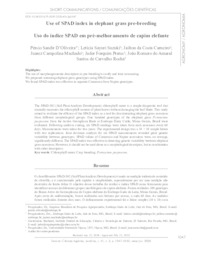Use of SPAD index in elephant grass pre-breeding.
Use of SPAD index in elephant grass pre-breeding.
Author(s): OLIVEIRA, P. S. d'; SUZUKI, L. S.; CARNEIRO, J. da C.; MACHADO, J. C.; PRATES, J. F.; ROCHA, J. R. do A. S. de C.
Summary: The SPAD-502 (Soil Plant Analysis Development) chlorophyll meter is a simple diagnostic tool that instantly measures the chlorophyll content of plant leaves without damaging the leaf blade. This study aimed to evaluate the efficacy of the SPAD index as a tool for discriminating elephant grass acessions from different morphological groups. One hundred genotypes of the elephant grass Pennisetum purpureum from the Active Germplasm Bank at Embrapa Dairy Cattle, Minas Gerais, Brazil were evaluated. Following uniform cutting, six SPAD readings were taken from each accession every 60 days. Measurements were taken for two years. The experimental design was a 10 × 10 simple lattice with two replications. Joint deviance analysis for six SPAD measurements revealed great genetic variability between genotypes. SPAD values of Cameroon and Napier accessions were, on average, significantly different. The SPAD index was effective in detecting genetic variability between elephant grass acessions. However, it should not be used alone as a morphological descriptor, but in combination with other descriptors.
Publication year: 2020
Types of publication: Journal article
Unit: Embrapa Dairy Cattle
Observation
Some of Embrapa's publications are published as ePub files. To read them, use or download one of the following free software options to your computer or mobile device. Android: Google Play Books; IOS: iBooks; Windows and Linux: Calibre.
Access other publications
Access the Agricultural Research Database (BDPA) to consult Embrapa's full library collection and records.
Visit Embrapa Bookstore to purchase books and other publications sold by Embrapa.

